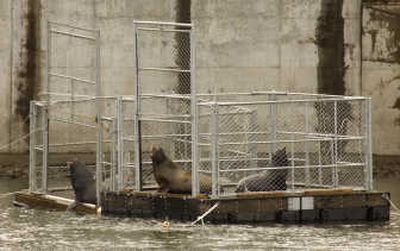Investigators say sea lion killers knew what they were doing

PORTLAND – Investigators think the killers navigated tricky waters in a restricted area, knew how to drop the doors of two metal cages, then began firing a high-powered rifle into six trapped sea lions, which would have tried to bolt at the first gunshot.
Carcasses of the sea lions were found Sunday in floating cages moored at the base of Bonneville Dam on the Columbia River.
In recent years, sea lions have been congregating there to dine on the spring run of endangered chinook salmon trying to get upstream to spawn. Wildlife agents last month started to trap them and remove those who had been marked as the worst offenders.
But only one of the victims was among the California sea lions that had become Bonneville regulars, said Bob Lohn, regional administrator of the National Marine Fisheries Service.
Two were of another sea lion species, the Steller, that prefers sturgeon over salmon. Among the others was a recent arrival at the dam and a pup.
The trapping has been suspended amid fears of some of its proponents that the violence would cause a backlash against it.
Veterinarians examining the sea lions Monday were unable to find bullets, said Brian Gorman, a spokesman for the National Marine Fisheries Service.
Because the drop-down doors were closed and because it appeared the bullets went through the bodies, investigators discounted scenarios that had gunshots fired from the Washington side of the river, about 500 yards away, Gorman said.
Normally, the doors are left open to get the sea lions used to the cages until trappers are ready to remove some, he said.
The traps were next to an island, and the theory Monday was that whoever did the shootings came by boat. U.S. Army Corps of Engineers spokeswoman Diana Fredlund said the currents are complex and unpredictable as water issues from two powerhouses and the spillway.
“Suffice it to say that in order to undertake (the shootings) this person would have to be somewhat familiar with the trapping methods used there and the operation of the traps,” Lohn said.
The trapping started April 24. The federal government gave the states of Washington and Oregon permission to capture or kill up to 85 sea lions a year for five years.
At the request of the Humane Society of the United States, a federal appeals court has disallowed the killing until it hears arguments – a hearing is scheduled Thursday. The sea lions removed so far have been sent to zoos and aquariums, although one died under anesthesia before it could be transferred to Sea World.
Both California and Steller sea lions are covered by a federal law that protects marine mammals. The salmon are protected by the Endangered Species Act.
Indian tribes protecting their traditional fisheries and state governments representing commercial and sport fishermen promoted the sea lion removal.
“Just as we appeared to have gotten to a working management strategy, this happens,” said Charles Hudson, spokesman for the Columbia River Inter-Tribal Fish Commission.
He said the tribes were “deeply disappointed” at the killings and asked for public patience with the trapping. He also said the commission has 14 fisheries agents in the area who will aid the investigation. “Our enforcement has some of the best eyes and ears on the river,” he said.
“Luckily, I was in Astoria, so you can’t blame me,” said commercial fisherman Brian Tarabochia, who said a fishing friend proposed, not entirely in jest, setting up a legal defense fund if someone is arrested for the crime. Astoria is at the mouth of the river, 146 miles downstream from the dam.
He said the killings don’t accomplish anything, but they do demonstrate frustration over the sea lions.
The Humane Society condemned the killings on Sunday, and a few animal rights activists went to the dam on Monday to protest against the killings. A Tucson, Ariz., group called the Animal Defense Council said it would pay a $500 reward for information leading to an arrest and conviction.